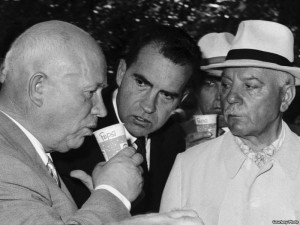There is obviously a deep human desire for sweetness, and blackness (in your tummy, fool, Heaven forbid the other!), and a good swift jolt of the jitters. Once upon a time, spices drove economies—and thus politics—but today we have Coca-Cola and its descendents. Just over one billion cans of Coke are sold each day across the globe. Short of North Korea and the Mongolian Steppes, you’d be hard pressed, I suspect, to find someone who hasn’t tasted it. Coke is America’s ambassador; Wikipedia lists 52 non-Coke colas, all built on the Coke template.
Now, if you’re a country that wants no truck with The States, you’ve got to come up with your own competitor to sate your masses. Iran has three native colas, including Parsi Cola and Zam Zam Cola, the latter of which was owned by Pepsi from its creation in 1954 until the Revolution in 1979.
The Well of Zamzam is located 66 feet from the Kaaba, that big granite cube that everyone on the Hajj circles. In Islamic lore, it sprung up from the desert at the word from God when Abraham’s son Ishmael was crying from thirst. In the 2000s, Mecca Cola emerged from the U.K. to compete with Zam Zam, and a fourth Muslim cola, Evoca, boasts as its secret ingredient black seed, of which Mohammed apparently said, “It is the cure for all diseases but death.”
Perhaps Vatican alchemists are working on the Gethsemane Gulp as I type.
Trailing behind Coke—at a mere 1 million cans consumed per day—is the red, white, and true blue Pepsi Cola. Though Coke had a special and public place in the lives of J.F.K., L.B.J., and Mr. Jimmy Carter, it is Pepsi‘s most symbiotic relationship with Mr. Richard Milhous Nixon that is well worth relating.
While Eisenhower’s veep in 1959, Nixon traveled to the American National Exhibition in Moscow, a “Get to know your Cold War cousins”-kind of show in which an 80-foot-high geodesic dome housed exhibits on American agriculture and labor, an IBM robotic ambassador that answered pre-selected questions like “How much does an American cigarette cost?”, 22 of the latest models out of Detroit, and a collection of paintings and sculptures—hand-picked by Ike—that included Pollock and Calder.
A man of genius, Donald Kendal, was also at the exhibition. As head of Pepsi’s fledgling international arm, he ignored his bosses’ belief that no commercial benefit could come from partnering with a Communist country and set up a booth that would ultimately distribute 10,000 free cups of cola every hour for the whole 42 days of the show. Kendal got a promise from Nixon before hand, and one of those cups ended up in the hand of Nikita Khrushchev. Pepsi ended up on the cover of Soviet newspapers, Kendal jumped a few rungs and took his bosses’ positions, and Nixon had a new friend.
After Nixon lost the Presidential race to Kennedy and then a gubernatorial bid in California, he found himself in need of a job. Kendal hired him as Pepsi’s lawyer. Nixon then proceeded to fly around the globe—partly on Pepsi’s dime—meeting with the world’s heads of state. He’d shake hands, and smile for the cameras, and tell the masses back home that he’d assume the honor of the GOP Presidential nomination if offered it. Behind him came Kendal, promising those heads of state that a country doing business with Pepsi would have a keen ear in the imminent Nixon White House. In a later interview, Kendal recalled his difficulties getting Pepsi into Taiwan. Nixon arranged a meeting with Chiang Kai Sheck. “And that solved that problem,” Kendal said.
When Nixon finally did land the White House, Pepsi negotiated a barter deal in which capitalist Pepsi syrup was traded for communist Stoli vodka. Ronald Reagan later ridiculed Nixonian foreign policy, declaring its greatest achievement “selling Pepsi Cola in Siberia,” but the drink was the first American product on Soviet shelves. In 2004, Putin would award Kendal a Russian Order of Friendship honor when the exec was 93-years-old.
So Pepsi blew up and got its share of the global market. For twenty years it was the primary American cola sold in Arab countries (Coke took Israel, since never the twain shall meet) though in 2003 it did lose the chance to be the “official drink of the Summit of the Organization of the Islamic Conference.” Mecca Cola took that one with its “Message in a Bottle” marketing campaign, albeit only after losing its bid the previous year to be the “official soft drink of the Hajj.” That was Zam Zam’s score. And Coke still has Christmas and Santa locked down.
(Thanks to Alexandra Jopp for the details of the Moscow exhibit.)

